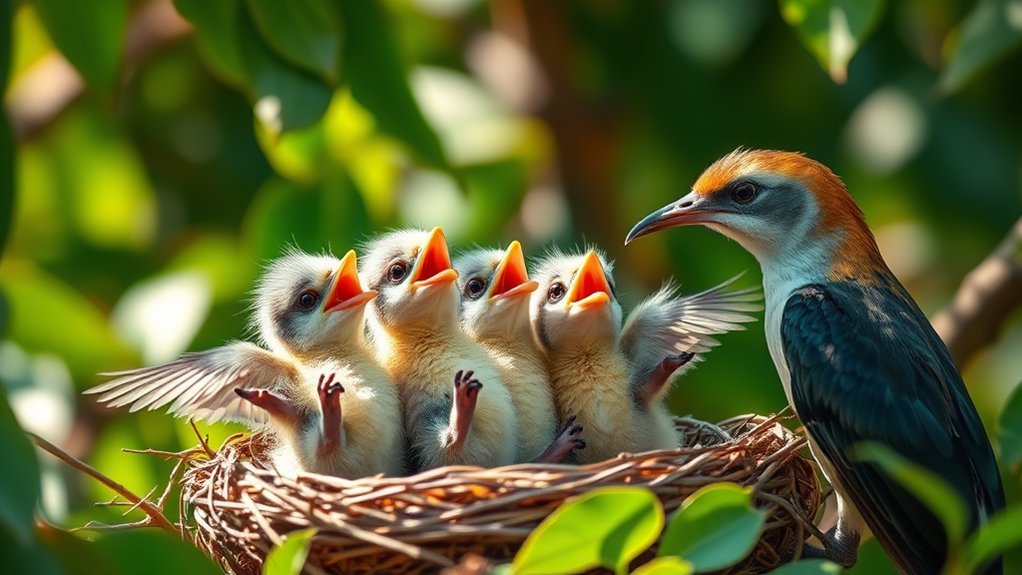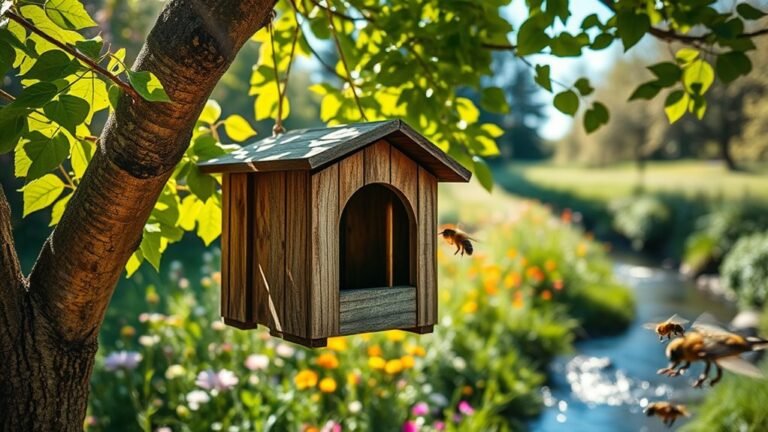How Long Does It Take Baby Birds to Fly? From Hatchlings to Flyers
The time it takes for baby birds to fly varies by species. Sparrows can learn to fly in just a few weeks. In contrast, eagles may take several months. Each species grows at its own pace, influenced by its environment and the care it receives from parents. Understanding these timelines can help us appreciate their survival strategies. Exploring the growth patterns of different birds is both interesting and informative.
Key Takeaways
- Sparrows usually learn to fly within two weeks after they hatch.
- Eagles take about 12 weeks to fly independently.
- Larger bird species often need more time to develop essential survival skills.
- After leaving the nest, fledgling birds start testing their wings and exploring their surroundings.
- During flight training, fledglings face challenges like finding food and avoiding predators.
The Hatching Process: The Beginning of a New Life
When a mother bird lays her eggs, a fascinating process starts inside the shells. During egg incubation, the embryos develop through several important stages that are necessary for their survival.
Temperature and humidity are crucial factors, and the mother bird keeps the nest warm by sitting on it.
As they grow, the embryos form feathers and organs while safely inside their shells.
After several days of care, the hatchlings prepare to break free. They use their beaks to crack the shell.
This amazing event often happens in sync, with some chicks hatching just hours apart.
Observing this moment reveals the beginning of life and highlights the strength the young birds will need for their future.
The Nestling Stage: Dependence and Growth
When hatchlings come out of their eggs, they enter the nestling stage. This stage is marked by their complete reliance on their parents.
You'll see young birds displaying behaviors that show they need adults for food, warmth, and safety. They grow quickly, reaching important milestones like growing feathers and building muscle.
At first, nestlings are helpless. They can't keep their body temperature stable or feed themselves. As they grow, their calls change slightly, expressing their needs.
The parents consistently provide food and care, creating a supportive environment that strengthens social bonds. By the end of this important stage, nestlings acquire the strength and coordination necessary for the next phase of their lives.
The Fledgling Phase: Testing Wings
The fledgling phase is a key time in a young bird's life. During this stage, young birds start to test their wings and explore what lies beyond the nest. You'll see them flap their wings vigorously, which helps to build the strength they need for flight. Often, they sit at the nest's edge, looking out and getting ready to discover their new surroundings.
This exploration helps them build muscle, improve coordination, and learn how to fly. You might notice them hopping to nearby branches. As they do this, they gain confidence and learn to balance, which is important as they figure out how to manage height and distance.
Each attempt they make takes them closer to flying, helping them become independent and feel more at home in their environment.
Timeframes for Different Bird Species
Bird species have different timelines for fledging, which is interesting to observe in nature.
For example, sparrows typically fledge within two weeks after hatching. They start using their wings in safe areas like shrubs and grass.
On the other hand, young eagles take longer to become independent. They may depend on their parents for up to 12 weeks before they can fly. Eagles are larger and need more time to learn how to hunt.
Observing these differences helps you appreciate bird life and understand that each bird has its own journey to independence.
The Role of Environmental Factors
Young birds prepare for flight, and environmental factors shape their development. The habitat provides food, shelter, and safety. Climate conditions also play a role in their growth, with warmer temperatures speeding up their readiness to fly.
- A fledgling sits in a soft grassy spot.
- A gentle breeze supports its first unsteady flight.
- A parent watches closely from a nearby branch.
Each part of their environment influences their journey. Learning to fly becomes a physical challenge connected to their surroundings.
Parental Care and Its Impact on Development
Parental care is crucial for baby birds. It helps them develop properly and prepares them for flight. Parents feed, groom, and protect their young.
This care allows chicks to gain strength and coordination needed for flying. As they grow, fledglings look to their parents for help in learning important skills like finding food and avoiding predators.
This nurturing not only supports physical growth but also builds their confidence, which is essential for successful flying. Without adequate parental support, baby birds can struggle to reach these important milestones.
This can threaten their survival and ability to thrive in nature.
Signs That a Baby Bird Is Ready to Fly
Signs That a Baby Bird Is Ready to Fly
As baby birds grow and gain confidence, several clear signs indicate they're ready to fly. Watching these signs unfold can be a touching experience. Here are the key indicators to look for:
- Increased Wing Flapping: Baby birds will flap their wings more often. This shows they're building strength and improving their coordination.
- Frequent Stretching and Preening: When baby birds stretch and groom their feathers, it suggests they want to prepare for flight. Well-groomed feathers help them fly better.
- Exploration: Baby birds that start to explore their surroundings indicate a desire to leave the nest. This curiosity shows they're ready to take the next step.
These behaviors are strong indicators of a bird's readiness to fly. As they develop these skills, it becomes clear they're preparing to soar. This moment marks an important step in their growth.
It's an exciting time for both you and the baby bird!
Common Challenges Faced by Young Birds
Young birds face several challenges after leaving the nest. One major issue is the risk of being eaten by predators. Fledglings are vulnerable to threats like cats, birds of prey, and snakes. Their lack of experience makes it hard for them to survive in the wild.
Another challenge is finding enough food. While their parents provide a balanced diet when they're young, fledglings must learn to search for food on their own. They may have difficulty locating enough nourishment, which can lead to nutrition problems that affect their health and growth.
Observing these struggles can help bird enthusiasts appreciate the resilience of young birds and the delicate balance of nature.
Frequently Asked Questions
How Do Baby Birds Learn to Fly From Their Parents?
Baby birds learn to fly with help from their parents. Parents watch over them as they practice. They encourage their young to flap their wings and try short jumps. This guidance builds the baby birds' confidence and skills. Parents gradually expose them to open spaces, allowing them to grow and improve their flying abilities.
Can Baby Birds Fly After Just One Day of Leaving the Nest?
Baby birds usually need more than one day after leaving the nest. They take time to learn how to fly properly. Different bird species stay in the nest for varying lengths of time, ensuring they are ready before they fly. This period allows them to develop their strength and skills for successful flight.
What Predators Threaten Baby Birds During Their Development?
Baby birds face several threats while they develop in their nests. Predators like hawks and crows often hunt them. Additionally, storms can damage nests and harm the young birds inside. Human actions such as cutting down trees or building in nesting areas also reduce their chances of survival. Each of these factors plays a significant role in the life and growth of baby birds. Protecting their environments can help increase their survival rates.
Do Baby Birds Practice Flying Before Leaving the Nest?
Yes, baby birds practice flying before they leave the nest. They flap their wings a lot. This builds their wing strength. It also helps them improve coordination. Both of these skills are important for taking off successfully. Watching this behavior shows how they prepare for their future challenges. This practice is crucial for their survival.
How Can I Help a Baby Bird That Has Fallen From Its Nest?
If you find a baby bird that has fallen, gently help it. First, check the area around the bird. Then, prepare to care for it. Wear gloves to avoid stress for the bird. Make the bird comfortable as you plan to return it to its nest safely.

Ava is a bird enthusiast and nature lover who has spent countless hours observing and learning about the fascinating world of birds. With a passion for sharing her knowledge and inspiring others to appreciate the beauty of birds, Ava writes about her experiences and insights on avianadmirer.com.







